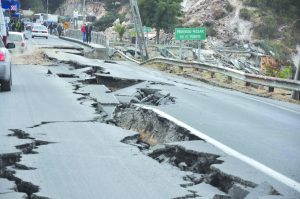 The Indian subcontinent has a history of earthquakes. The reason for the intensity and high frequency of earthquakes is the Indian plate driving into Asia at a rate of approximately 47 mm/year. The latest one before this edition went to bed was the strong 6.1-magnitude earthquake that struck the country’s northeastern state of Arunachal Pradesh early on April 24. The epicenter of the shallow quake was about 40 kilometres southeast of Along, and 180 kilometres southwest of the state capital Itanagar.
The Indian subcontinent has a history of earthquakes. The reason for the intensity and high frequency of earthquakes is the Indian plate driving into Asia at a rate of approximately 47 mm/year. The latest one before this edition went to bed was the strong 6.1-magnitude earthquake that struck the country’s northeastern state of Arunachal Pradesh early on April 24. The epicenter of the shallow quake was about 40 kilometres southeast of Along, and 180 kilometres southwest of the state capital Itanagar.
Such quakes are minor. But a mega earthquake of magnitude 8.5 or more is long overdue in the Himalayan region. Sadly, India has not learnt from past mistakes and is far from being prepared for such an eventuality with no strategy to minimise loss of life and property. The government must ensure seismic safety, scientists from all over the country who gathered here last week for a global workshop said.
The April 18-20 International Workshop on Climate Change and Extreme Events in Himalayan Region, hosted by the Indian Institute of Technology (IIT) Mandi, was aimed at understanding the effects of climate change, melting of glaciers, increased frequency of extreme events, atmospheric pollution, pollution due to crop residue burning in Himalayan region and applications of remote sensing. Scientists from various fields of expertise concurred that an earthquake of the magnitude of 8.5 or more is expected to rock the Himalayan region.
One of the many topics discussed at the event was that the Himalayan region was not prepared to reduce loss of lives and properties when the ‘big one’ arrives. Numerous research groups, including one at IIT Roorkee, are in the process of developing earthquake early warning systems which could give people up to a minute of warning before the quake. However, such short term predictions are not best way forward, said Dr Supriyo Mitra from Indian Institute of Science Education and Research (IISER), Kolkata. “I would prefer being a society that is prepared,” Mitra was quoted as saying.
Even if seismologists are able to provide an early warning to enable people to safely vacate their buildings before an earthquake, our homes would still be destroyed, turning a whole society into refugees, he said. “We have the expertise to know what the hazards are. Engineers can work out the vulnerability of the structures and tell you the mechanism by which they can be made resistant,” said Mitra, one of the speakers at the workshop.
Implementing these would reduce the risk to human lives and property in the event of a disaster. “Science can tell you where an earthquake may strike, and with what magnitude, but ‘when’ is a bad question to ask,” Mitra said, adding that earthquake predictions shift the onus of responsibility of disaster preparedness completely to scientists.
Heavy damage awaits Delhi-NCR
If a large magnitude earthquake occurs in the near future in the northwest (NW) Himalayas region as predicted by a recent study, the National Capital Region (NCR) of Delhi would suffer very heavy damage. The 2001 earthquake in Bhuj in Gujarat, which claimed about 10,000 lives, had shown that the destruction by an earthquake is caused by two different types of waves: Shear Waves, confined to about 70 to 100 km from the epicentre and which adversely affect the foundations and basements of structures; and Rayleigh Waves that travel with a velocity between 2.5 to 3 km per second and produce a different type of destructive effect.
These Rayleigh Waves from earthquakes of magnitude above 7.5 become active at a distance beyond 150 to 200 km or more from the epicentre and adversely affect tall structures (height more than 17 meters) as was observed at Ahmedabad city located at a distance of about 320 km from the Bhuj earthquake’s epicentre. Another very important observation was that all structures with “stilted” floors (where the ground floor is used for vehicle parking) were severely damaged. A similar damaging effect by Rayleigh waves was observed in Mexico City, located about 500 km from the epicentre of the 1985 earthquake.
The Himalayan states had been visited by a number of large magnitude earthquakes and a recent study suggests the NW region (mostly Uttarakhand, Himachal Pradesh and parts of Kashmir) is ripe for one. The Delhi NCR escaped major damage from the destructive Rayleigh Waves from past earthquakes because, prior to 1950, there were no high rise buildings there.
But the situation is now different. With its satellite townships of Noida, Greater Noida, Gurugram, Ghaziabad and Faridabad, NCR Delhi forms a big cluster of high-rise buildings with flyovers, bridges and elevated roads. It is also known that some of the high-rise structures have collapsed during construction itself. Many high-rise buildings have stilted floors. As was witnessed in Ahmedabad after the Bhuj earthquake, all these structures could suffer heavy damage in case of a large magnitude earthquake in the NW Himalayan region with its epicentre in the range of 270 to 350 km from NCR Delhi.
The Himalayan fault is known to have a potential to generate earthquakes up to a magnitude of 8 or more. The foundations in Delhi are not on solid rock but there is excess of soil and crushed rock (murrum) on the ground. In case of a powerful earthquake in the Himalayas, the long scissors of Rayleigh Waves could wildly chop the tall concrete structures in Delhi and neighbouring areas. The possibility that these buildings may collapse like a pack of cards in “Ahmedabad Fashion” cannot be ruled out.
Fluctuations in the Earth’s rotation are tiny – changing the length of the day by several milliseconds – but could be enough to release vast amounts of underground energy, they have said. It has been reported that on five occasions in the past century, a 25-30 per cent increase in annual number of earthquakes (of magnitude 7 or greater) coincided with a slowing in the mean rotation velocity of the Earth. The slowing down of Length of Day (LoD) normally lasts for six years, after which the earth enters a period of enhanced seismicity. In this century, the LoD started in 2011 and now the year 2018 could be considered a period of higher seismic activity. While the research did not indicate precisely when and where these future earthquakes will occur, it showed that most of the intense earthquakes that responded to changes in day length seemed to occur near the equator.
Public involvement
However, to ensure preparedness, the public needs to be involved in questioning whether their buildings are safe. Participants at the workshop, as per a news agency report, also raised questions on how socio-economically weaker sections would invest in building earthquake resistant buildings. Dr Durgesh C Rai from IIT Kanpur said it is the right of every individual to have seismic safety, and the government has to ensure that. “Seismic safety should not be an optional requirement,” he said.
While presenting his research, Rai focused on how publicly-funded government buildings in Himalayan states such as Sikkim and Manipur could not survive even low intensity earthquakes. According to him, we continue to repeat the same mistakes time and again, and have not learnt any lessons from the failures of the past. Giving the example of the 1993 earthquake that struck Latur, Maharashtra — killing over 9,000 people — Rai said government agencies and academicians were of the view that buildings which collapsed were non-engineered. “So the deaths of people were linked to their poverty,” he added.
“In 2001, the Bhuj earthquake — 120 multi-storey buildings collapsed in Ahmedabad — killed over 900. This was engineered construction. The investigations showed that every building code was flouted,” Rai said. “Earthquakes need not be deadly or destructive if we use the right designs and materials.” He added that seismic safety should not be an optional feature that people have to ask for. Rather, all buildings should be built to be earthquake safe by default — much like medical instruments are sterilised before use, irrespective of whether a patient is rich or poor. He pointed out that many older buildings in the Himalayan arc have survived earthquakes for decades, and these could serve as lessons for our future. “Loss of life occurs due to building collapse and damage, we need to engineer structures with proper building codes,” said Ramesh P Singh, coordinator of the workshop, and visiting professor at IIT Mandi.
letters@tehelka.com












